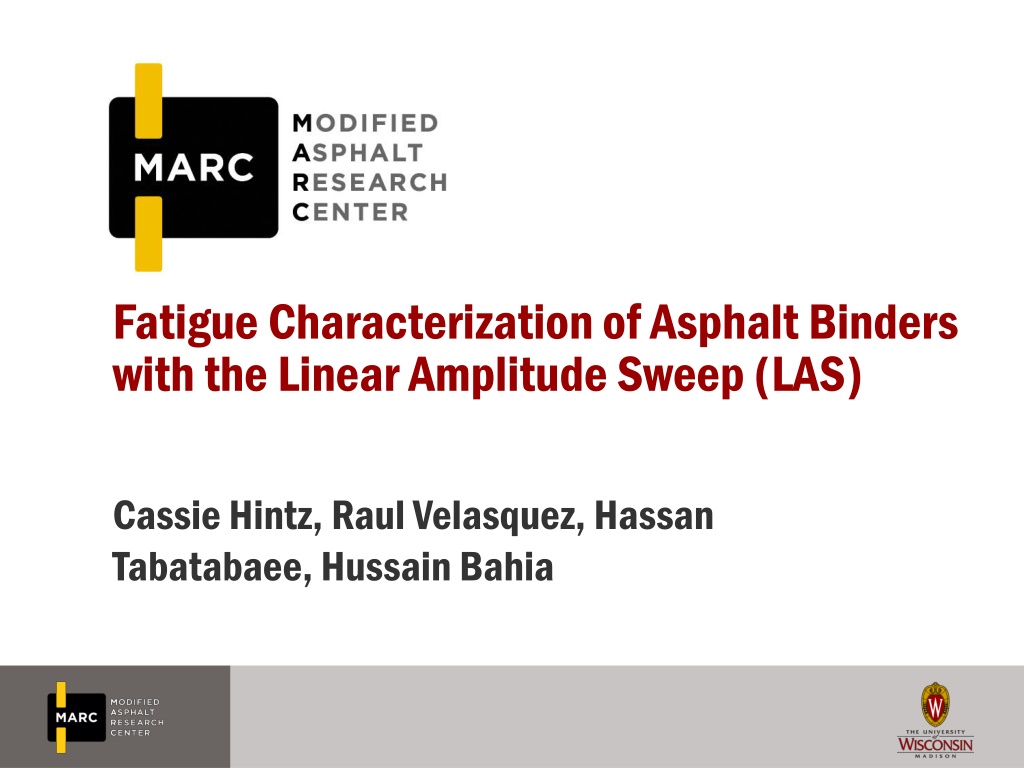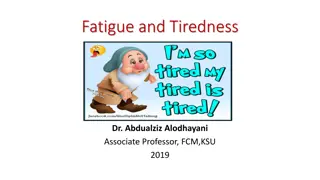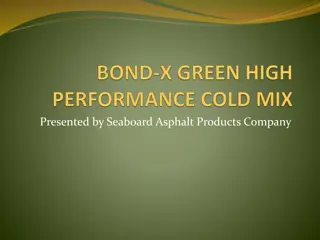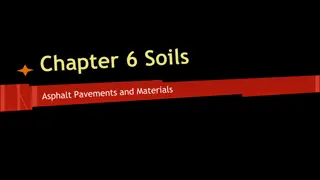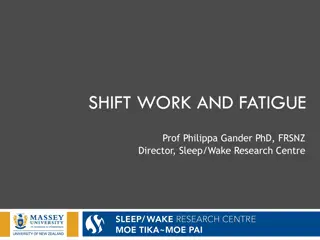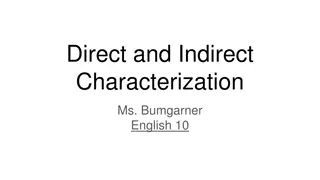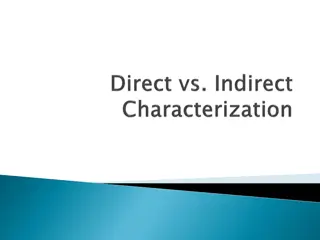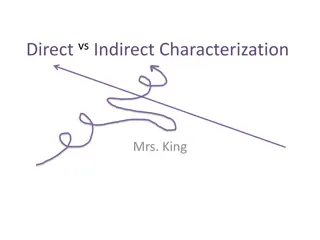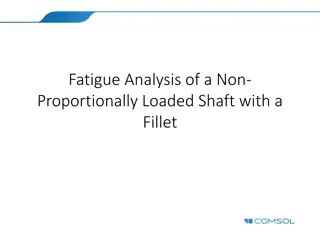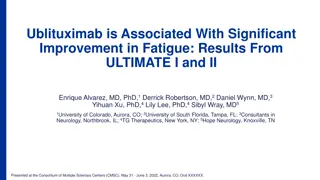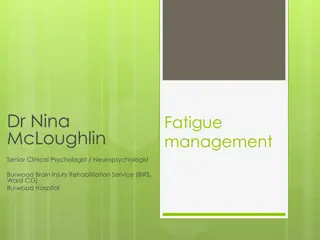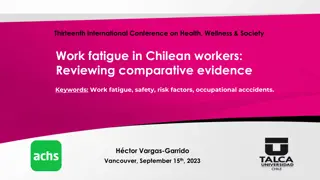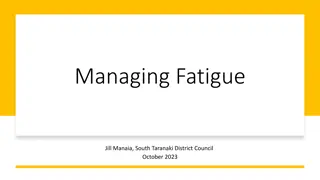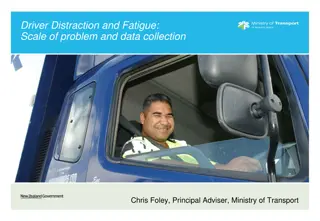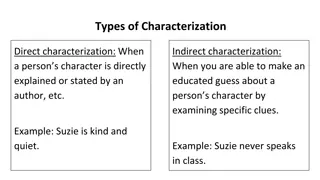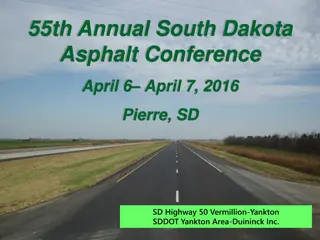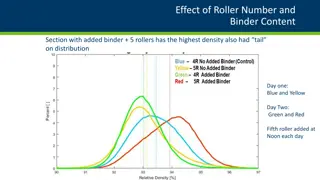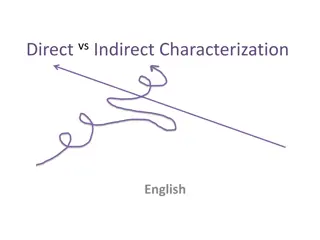Understanding Asphalt Binder Fatigue Characterization
This comprehensive study delves into the fatigue characterization of asphalt binders using Linear Amplitude Sweep (LAS) testing. It covers various aspects such as theoretical foundations, testing methods, equipment used, and analysis of results. Additionally, it explores Superpave specifications, binder fatigue laws, and the application of Viscoelastic Continuum Damage (VECD) analysis in assessing asphalt mixture fatigue. The research provides valuable insights into the performance evaluation of asphalt materials under different conditions.
Uploaded on Sep 25, 2024 | 0 Views
Download Presentation

Please find below an Image/Link to download the presentation.
The content on the website is provided AS IS for your information and personal use only. It may not be sold, licensed, or shared on other websites without obtaining consent from the author. Download presentation by click this link. If you encounter any issues during the download, it is possible that the publisher has removed the file from their server.
E N D
Presentation Transcript
Fatigue Characterization of Asphalt Binders with the Linear Amplitude Sweep (LAS) Cassie Hintz, Raul Velasquez, Hassan Tabatabaee, Hussain Bahia
Content Part 1: Binder Fatigue Testing Part 2: LAS: Theoretical Base Part 3: Performing the LAS test Anton Paar Rheometers TA Rheometers Bohlin Rheometers Part 4: Analysis of LAS results
PART 1: BINDER FATIGUE TESTING BINDER FATIGUE TESTING
Superpave Bitumen Tests Related to Performance Related to Performance! Climate -- PG HT-LT Traffic Speed DSR Traffic Volume PG shift Traffic loading NA Pavement Structure NA Assumption: Bitumen in Linear VE range DSR DT Dynamic Shear Rheometer Direct Tension Test RV BBR Rotational Viscometer Bending Beam Rheometer
Binder Fatigue: Superpave Specification (|G*| sin ) Data from NCHRP 9-10
Background Asphalt Mixture Fatigue Asphalt mixture fatigue characterization relies on following fatigue law: Number of Cycles to Failure = A (Applied Load)B MEPDG Model: 3.9492 1.281 1 1 E 00432 . 0 = * ' * N k C stiffness / temperature 1 f traffic t 1 = ' k structure 1 003602 . 0 + + 0.000398 (11.02 - 3.49 hac) * 1 e where: hac = Total thickness of the asphalt layers
Background Asphalt Fatigue = B ( ) N A max f
Background VECD Viscoelastic Continuum Damage (VECD) analysis has been used for asphalt mixtures since the late 1980 s. Relies on constitutive modeling to determine the deviation of damaged test results from undamaged properties. Deviation from initial undamaged properties with respect to number of cycles used to calculate damage. Characteristic plot used to back-calculate fatigue performance under different testing conditions.
Background Summary Asphalt concrete has been shown to have a well- defined relationship between loading input and fatigue life. VECD analysis can be an effective tool to determine damage characteristics. Conventional binder fatigue procedure (time sweep) is problematic. Binder fatigue testing needs an efficient procedure that can do more than rank relative performance for a single condition.
PART 2: LINEAR AMPLITUDE SWEEP: LINEAR AMPLITUDE SWEEP: THEORETICAL BASE
NewTest Method Linear Amplitude Sweep Employs the DSR and standard geometry Systematically increases applied load to accelerate damage Strain-controlled to avoid accumulated deformation Use of VECD allows for calculation of fatigue life at any strain level
New Test Method Frequency Sweep+
Background Asphalt Fatigue = B ( ) N A max f
Fatigue Law Parameter B B = -2 obtained from frequency sweep can be calculated using the slope of log-log G ( ) plot where G ( )=|G*| cos ( ) = 1 + 1 / m where m is slope of the log-log G ( ) plot
Fatigue Law Parameter A Where Df = (0.35)(C0 / C1)^(1 / C2) Damage at failure: Failure corresponds to a 35% reduction in G* sin f = Loading frequency (10 Hz). k = 1 + (1 C2) ID=undamaged complex modulus C1 and C2 come from curve fit: Where D = damage
Damage Curve VECD Damage Curve from Amplitude Sweep 14.0 12.0 |G*| sin [Pa] 10.0 8.0 Amplitude Sweep 6.0 Fit 4.0 2.0 0.0 0 2,000 4,000 D(t) 1 i 6,000 8,000 N ( ) 1 ( ) 2 0 ( ) * sin * sin D t I G G t t + 1 + 1 1 D i i i = 1 i
Parameters C1 and C2 Model can be linearized to determine curve coefficients: Y = + x C0 is average |G*| sin from the 0.1% strain step log(C1) is intercept and log(C2) is slope of log(C0 - |G*| sin ) versus log(D(t)) **IGNORE DATA CORRESPONDING TO D(t) less than 100
Linearized Damage Curve y = 1.0905 + 0.4989x 0.80 0.70 R = 0.9983 0.60 sin |G*| sin 0.50 log(C0 0- -|G*| 0.40 0.30 log(C 0.20 0.10 0.00 2 2.5 3 3.5 4 log(Damage) log(Damage)
Summary The LAS test is a DSR procedure consisting of a frequency sweep and strain amplitude sweep Goal: derive fatigue law Parameters A and B are binder properties A from amplitude sweep Higher A increases fatigue life B from frequency sweep Higher magnitude of B decreases fatigue life (at a constant A) ( )B = N A max f Traffic Structure
PART 3: PERFORMING THE LAS TEST: PERFORMING THE LAS TEST: (a) ANTON-PAAR RHEOMETERS
Anton-Paar Rheometers The test has been successfully tested on the following Anton-Paar Rheometers: MCR 300 (Smartpave) MCR 301 Direct Strain Oscillation (DSO) module recommended but not required
Anton-Paar Rheometers 16 A % Difference 14 With DSO Without DSO 8.04E+06 8.75E+06 8.47% 12 Strain (%) Strain (%) 10 8 Without DSO 6 4 With DSO 2 0 0 20 40 60 80 100 120 140 Time (sec) Time (sec)
Anton-Paar Rheometers Video
PART 3: PERFORMING THE LAS TEST: PERFORMING THE LAS TEST: (b) TA RHEOMETERS
TA Rheometers Procedure can be run as specified in AR2000 EX AR2000 at UW does not have capability to conduct procedure exactly as specified but results are not substantially affected Cannot allow for 100 cycles of loading per strain exactly (typically includes 120-140 cycles per strain step) Cannot generate one point per second (able to obtain approximately one point every three seconds)
TA Rheometers Video
PART 3: PERFORMING THE LAS TEST: PERFORMING THE LAS TEST: (b) BOHLIN RHEOMETERS
Bohlin Unable to successfully conduct LAS test in UW s Bohlin C VOR-200 rheometer DSR stops oscillating between strain steps Malvern support stated their Kinexus rheometers are capable of running procedure Contact with Malvern support revealed there was no solution UW s rheometer requires several seconds to process data between each strain step Faster computer will reduce rest between strain steps but will not eliminate the problem
PART 4: ANALYSIS OF LAS RESULTS
Analysis of LAS Results Analysis is easily carried out using prepared MS Excel spreadsheets
Analysis of LAS Results Video
Summary Linear Amplitude Sweep is being proposed to address concerns over current specification Efficient and practical, uses existing equipment and testing geometry VECD analysis can be employed to account for traffic and pavement structure
Thank You! Questions? Questions? UWMARC.org UWMARC.org
